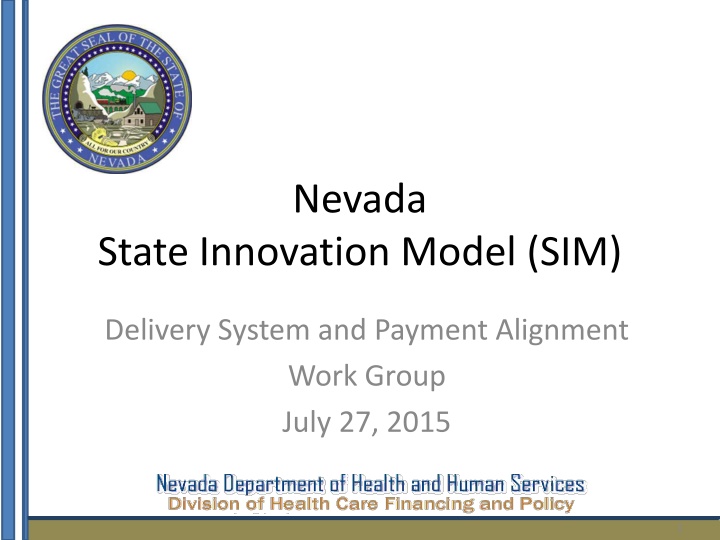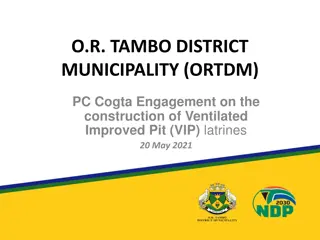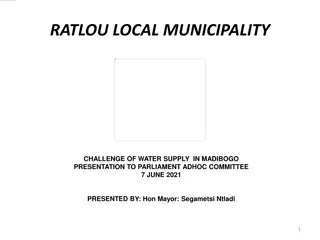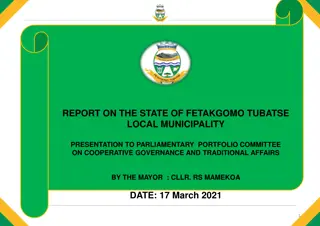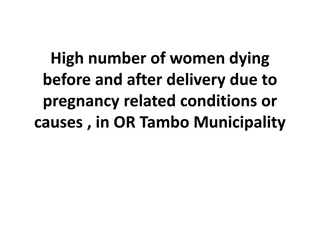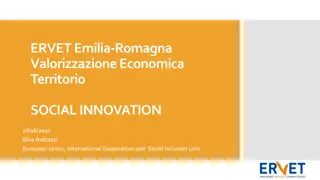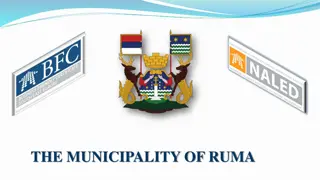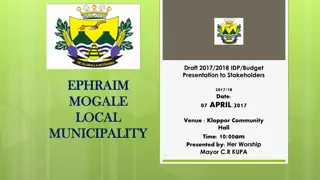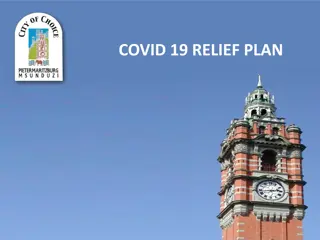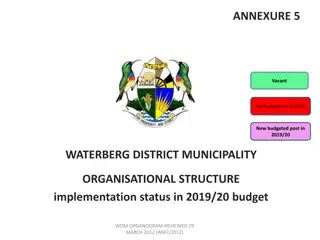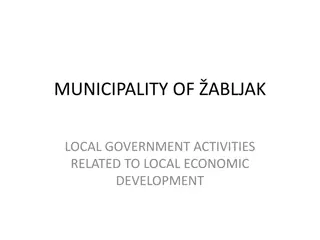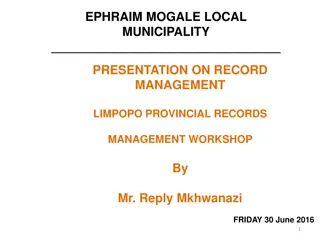Research Project on Reggio Emilia Municipality's Economic Structure
The research project conducted by Mario Minoja and Elisa Mori from the University of Modena and Reggio Emilia explores the demographic, socio-economic, and economic structures of Reggio Emilia municipality. It delves into aspects such as per capita income, employment rates, firms distribution, and export performance, highlighting the region's strong manufacturing industry, cooperative systems, and entrepreneurial landscape. The data presented showcases the growth, trends, and unique characteristics of the province, positioning it notably in Italy's economic landscape.
Download Presentation

Please find below an Image/Link to download the presentation.
The content on the website is provided AS IS for your information and personal use only. It may not be sold, licensed, or shared on other websites without obtaining consent from the author.If you encounter any issues during the download, it is possible that the publisher has removed the file from their server.
You are allowed to download the files provided on this website for personal or commercial use, subject to the condition that they are used lawfully. All files are the property of their respective owners.
The content on the website is provided AS IS for your information and personal use only. It may not be sold, licensed, or shared on other websites without obtaining consent from the author.
E N D
Presentation Transcript
Nevada State Innovation Model (SIM) Delivery System and Payment Alignment Work Group July 27, 2015 Division of Health Care Financing and Policy 1
Meeting Purpose To review the aim and drivers of change for Nevada SIM plan To discuss key components for successful delivery system reform and how to address those components To discuss and recommend a Nevadan PCMH model To discuss and recommend Nevadan Value-Based Purchasing (VBP) model PCMH MCO CMO DHHS, DHCFP - Nevada State Innovation Model (SIM) Project 2 Prepared by Myers and Stauffer
CMS Triple Aim Nevada Aim Target Areas Improved Health Outcomes Lower Cost Improved Patient Experience Improve Nevada s Health Status Ranking From 39th to 34thby 2019 While Maintaining Expenditures <= 2% of GSP Obesity Smoking Cessation Diabetes Behavioral and Mental Health Heart Disease/ Stroke DRIVER DIAGRAM CONNECTS AIMS TO TARGET AREAS DHHS, DHCFP - Nevada State Innovation Model (SIM) Project 3 Prepared by Myers and Stauffer
Primary Drivers Improve Health Ranking From 39th to 34th While Controlling Costs Improve Access to Care Redesign Delivery System Foster and Develop Health Information Technology and Data Infrastructure Development and Adoption Improve Patient Experience DHHS, DHCFP - Nevada State Innovation Model (SIM) Project 4 Prepared by Myers and Stauffer
SIM Payer Alignment Medicaid/CHIP Public Employees Health Benefit Program Indian Health Services Culinary Health Fund Other Payers (Phase In Over Time) Payer Nevada US Uninsured 20.5% 14.5% Employer/Military 52.0% 51.0% Individual 4.0% 5.4% Medicaid/CHIP 8.7% 13.4% Medicare 14.9% 15.8% Source: Data from 2013, SHADAC analysis of American Community Survey (ACS), Nevada State Profile (revised April 2015), page 10 DHHS, DHCFP - Nevada State Innovation Model (SIM) Project 5 Prepared by Myers and Stauffer
Population Health Measurement Strategy Start with nationally recognized quality stewards Customize where necessary Develop Value Based Purchasing (VBP) Approach May have to consider phased-in approach using process measures, reporting measures, and ultimately outcome measures Utilize a strong Health Information Technology and Data Strategy to support population health improvement Next steps Define strategies to improve population health in these areas Identify specific performance and outcome measures Work with HIT & Data Taskforce on analytic needs DHHS, DHCFP - Nevada State Innovation Model (SIM) Project 6 Prepared by Myers and Stauffer
Keys to Successful Delivery System Reform What? Enable Planning and Stakeholder Engagement Enable Effective Coordination and Support of Goals Develop Strong Data Infrastructure and Quality Measurement Develop Financing and Payment Methods that Incentivize the Goals Who? Governmental entities (federal, state and local) Community agencies (social services, housing) Payer (commercial, Indiana Health Services) Provider (primary care, hospitals) When? Identify implementation timelines Short term, mid term, long term goals DHHS, DHCFP - Nevada State Innovation Model (SIM) Project 7 Prepared by Myers and Stauffer
Keys to Successful Delivery System Reform Component State Community Payer Provider Multi-payer Collaborative Regional Health Improvement Offices Integration with Behavioral Health and Community Support Services Enable Coordination and Support Provider and patient education Integrated warehouse and analytic tools HIE and EHR system support Pool quality data Measure alignment PCMH adoption Medicaid Health Home Enhance Data Infrastructure and Quality Measurement Identify state and federal funding Participate in P4P Identify local funding Identify private funding Participate in P4P Participate in P4P Develop Financing and Payment Incentives DHHS, DHCFP - Nevada State Innovation Model (SIM) Project 8 Prepared by Myers and Stauffer
Enabling Coordination Convene a Multi-payer Collaborative (MPC) Brings together payers and employers in the state invested in reaching consensus to develop goals, measures and a provider payment model to meet the Nevada aim. Goals of the MPC would be: 1. Provide support on approach to provider practice transformation. 2. Create a PCMH PMPM payment framework. 3. Develop a standard, but flexible, Value-based purchasing (VBP) approach and support adoption. 4. Establish pay-for-performance (P4P) improvement goals. 5. Establish timelines for adoption of PCMH framework. 6. Agree to established performance measurement parameters for simplified reporting and accountability. DHHS, DHCFP - Nevada State Innovation Model (SIM) Project 9 Prepared by Myers and Stauffer
Enhancing Data Infrastructure Exchange and Quality Measurement Patient-centered Medical Home (PCMH) Medicaid Health Home Division of Health Care Financing and Policy 10
Six Required Services Definitions Comprehensive care management Health Home (Medicaid) Patient Centered Medical Home Care Coordination State flexibility in defining eligible providers Physician-led Health promotion Comprehensive transitional care/ follow-up Comprehensive, coordinated, continuous care Six specific services Patient and family support Beneficiaries with chronic conditions All populations Referral to community and social support services DHHS, DHCFP - Nevada State Innovation Model (SIM) Project 11 Prepared by Myers and Stauffer
Patient Centered Medical Home Goal: 80% of Nevadans connected with PCMH by December 31, 2019 Covers all populations across a life span Multi-payer model Physician-led primary care practices, but may include some mid-level practitioners Team-based coordinated care Reimbursement is for care coordination, typically through a per member per month payment and may include additional payments through VBP model DHHS, DHCFP - Nevada State Innovation Model (SIM) Project 12 Prepared by Myers and Stauffer
PCMH Model Examples Examples Payment Features General Criteria Common Fee-for-service Fixed supplemental per-member-per-month Pay-for-performance (P4P) Arkansas Risk-adjusted care coordination payment (ranging from $1 - $30 per attributed beneficiary per month; avg. $4 Medicaid Shared savings; upside-only based on 1) improvement from one year to another, 2) being a high performer in a state Statewide Multi-payer 5,000 patients Colorado Colorado Comprehensive Primary Care Initiative (CPCi) is a nationwide, multi-payer CMMI project for Medicare Risk-adjusted PMPM care management fee ranging from $8 to $40, avg. $20; Separate estimates for practice sites of 1-2 physicians, 3-5 or more physicians; Pay ranges established for each level of NCQA recognition Statewide Multi-payer Washington Washington State Multi-Payer Medical Home Reimbursement Pilot Care management fee of $2.50 PMPM in the first 8 months of the pilot, and $2.00 for the remaining 2 years 50% shared savings above the amount paid PMPM, if clinical quality maintained; potential for penalty if shortfall up to a maximum of 50% of PMPM Multi-payer Resource: Patient-Centered Primary Care Collaborative and CHCS DHHS, DHCFP - Nevada State Innovation Model (SIM) Project 13 Prepared by Myers and Stauffer
Nevada PCMH Approach Component Feature Phase 1/ Year 1 Phase 2/ Year 2 Recognition Achieve NCQA Accreditation Population Age 20 years and under 65 and over, disabled, Medicaid expansion Payers Multi-payer Payment Mechanism Fee-for-service Care Coordination PMPM VBP Incentive Payment Adjust for PCMH recognition levels Establish minimum patient threshold for VBP eligibility Medicare-specific payment Care Coordination PMPM VBP Incentive Payment Adjust for PCMH recognition levels Establish minimum patient threshold for VBP eligibility - Consider lump sum payment for recognition level achievement - Consider lump sum payment for recognition level achievement P4P Outcomes SIM conditions Youth focused Super-utilizers through risk- stratification DHHS, DHCFP - Nevada State Innovation Model (SIM) Project 14 Prepared by Myers and Stauffer
Health Home Models General Criteria Payment Features Examples ACA 2703 Health Home State Plan Amendment for low income adults with two or more chronic diseases or individuals with one chronic condition and at-risk for a second Medicaid Only Comprehensive care management Care coordination and health promotion Comprehensive transitional care from inpatient to other settings; including appropriate follow-up Referral to community and social support services Use of HIT to link services Fee-for-service payments Washington Risk-adjusted PMPM 3 Tiered Care Coordination payment Iowa Tier 1 (1-3 conditions) $12.80 Tier 2 (4-6) $25.60 Tier 3 (7-9) $51.21 Tier 4 (10 or more) $76.81 Eligible for P4P bonus of up to 20% of the total PMPM annually Resource: Patient-Centered Primary Care Collaborative and CHCS DHHS, DHCFP - Nevada State Innovation Model (SIM) Project 15 Prepared by Myers and Stauffer
Value-Based Payment and Service Delivery Model Division of Health Care Financing and Policy 16
Value-Based Payment Model Objective Align payment for health care services such that at least 80% of health care reimbursement is based on quality and outcomes by December 31, 2019. VBP has been discussed by the workgroups as being part of: Patient Centered Medical Home reimbursement Health Home/Superutilizer model Episode-based bundled payments Provider population health management performance Introduction of VBP and P4P concepts in public payer contracts DHHS, DHCFP - Nevada State Innovation Model (SIM) Project 17 Prepared by Myers and Stauffer
Value-Based Payment Model Standard VBP approach for all payers, with some flexibility. Each payer responsible for payments related to their patients. Commercial payers may be negotiate payments with hospitals within range. Common set of performance measures that have standard criteria. Clinical and Quality Workgroup will make recommendations for clinical performance measures. DHHS, DHCFP - Nevada State Innovation Model (SIM) Project 18 Prepared by Myers and Stauffer
Value-Based Payment Model Goal: Develop a PCMH Value-based Reimbursement Model Phased Approach 1. Phase I: Process/Participation measures 2. Phase II: Quality Reporting Capacity and Compliance Pay for Reporting 3. Phase III: Outcomes and Performance Pay for Performance 4. Phase IV: Shared Savings throughout the implementation process, historical and current cost and utilization analysis is conducted to determine the average PMPM cost for the PCMH patients. If the anticipated costs are maintained at no more than a specified level below the forecasted cost trend, the PCMH will receive a bonus. Or the PCMH begins to be paid on a PMPM versus fee for service that takes into the consideration the shared savings approach. 5. Phase V: Shared Loss If the anticipated cost trend is higher than a threshold of the forecasted trend, the PCMH incentive payments will be reduced by agreed upon allocation factors. Or the PCMH continues to be paid on a PMPM versus fee for service basis and the payment model transitions to a risk-model that is decreased based on the loss. DHHS, DHCFP - Nevada State Innovation Model (SIM) Project 19 Prepared by Myers and Stauffer
Value-Based Payment Model Phased- in Approach For Example Purposes Only: January 1, 2017: o 10 process and compliance measures begin to be reported, monitored and measured. Provider is reimbursed an incentive payment based on a pay for reporting/participating structure annually. January 1, 2018: o In addition to the 10 process and compliance measures collected, the provider now is required to report on 10 outcome measures on a semi-annual, or annual basis. o Pay for reporting for the new measures. o Pay for improved performance begins for measures reported and measured in 2017. January 1, 2019: o Pay for reporting is discontinued. o Pay for performance continues. o Shared Savings bonus begins or up-side shared savings approach. January 1, 2020: o Pay for performance continues. o Shared Savings incentive reduction applies, or down-side risk approach. DHHS, DHCFP - Nevada State Innovation Model (SIM) Project 20 Prepared by Myers and Stauffer
Delivery System and Payment Alignment Goals Baseline State and Future Expectation: CURRENT STATE Delivery System and Payment Model Medicaid Health Home CMO - Health Care Guidance Program PCMH MCO 293 NCQA Recognized PROVIDER/ ENTITY # 1 CMO Vendor 2 MCOs MEMBER LINKAGE # 41.5k - Medicaid 320k - Medicaid PAYMENT MECHANISM FFS FFS, Vendor Contract Full Capitation GEOGRAPHIC COVERAGE Statewide Statewide Clark, Washoe PAYER MIX Limited Medicaid Medicaid FUTURE STATE PROVIDER/ ENTITY # 1 CMO Vendor 2 MCOs 2.3 Million1 MEMBER LINKAGE # PAYMENT MECHANISM FFS, PMPM, VBP FFS, PMPM, VBP FFS, Vendor Contract Full Capitation, VBP GEOGRAPHIC COVERAGE Statewide Statewide Statewide PAYER MIX All Medicaid Medicaid Medicaid 1 Based on 80% of 2014 Census population estimate of 2,839,099 residents; http://quickfacts.census.gov/qfd/states/32000.html; Accessed July 17, 2015 DHHS, DHCFP - Nevada State Innovation Model (SIM) Project 21 Prepared by Myers and Stauffer
Questions to be addressed by the MPC Set common expectations for the following: Minimum threshold for patient panel Patient/payer assignment logic Patient/provider attribution model Incentive payment amounts Whether providers can pool practices for VBP Performance improvement goals DHHS, DHCFP - Nevada State Innovation Model (SIM) Project 22 Prepared by Myers and Stauffer
Health Information Technology Plan Division of Health Care Financing and Policy 23
HIT Plan State Health System Innovation Plan (SHSIP) must contain an HIT Plan HIT considered a fundamental infrastructure support transformation Health care delivery and payment system redesign must be accompanied by the appropriate HIT strategy DHHS, DHCFP - Nevada State Innovation Model (SIM) Project 24 Prepared by Myers and Stauffer
HIT Plan Areas to be addressed regarding the solution: Ownership Authority Governance Policy/legal agreements Technical architecture Business and technical operations Financing Sustainability Needs Identified to Date: Ability to electronically capture health care and related data for Nevadans An analytics tool that can measure population health and related outcomes for Nevadans More than just claims data more than HIE data Enterprise Master Patient Index Strong privacy considerations DHHS, DHCFP - Nevada State Innovation Model (SIM) Project 25 Prepared by Myers and Stauffer
Discussion Next Meeting Objective Determine Timeframes and VBP for State Contracts Division of Health Care Financing and Policy 26
